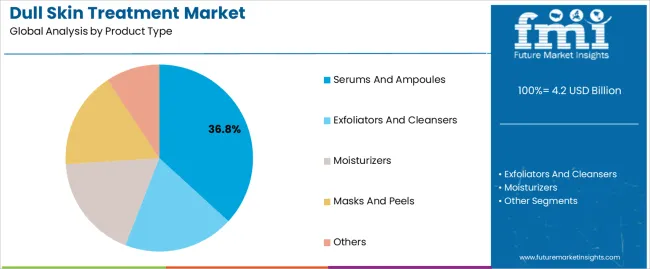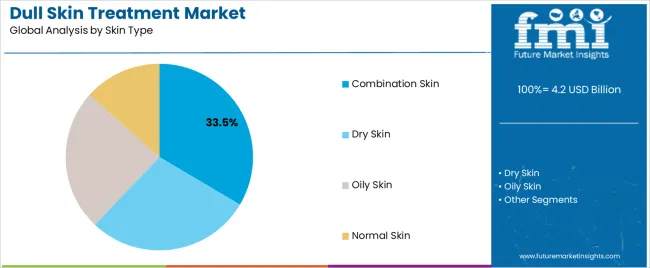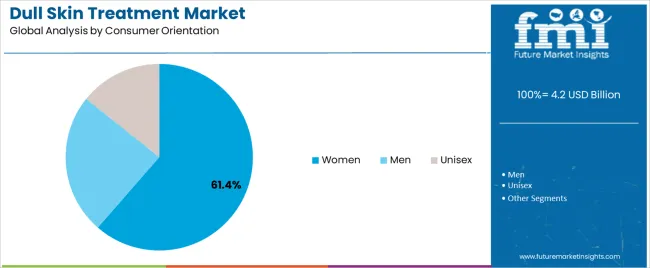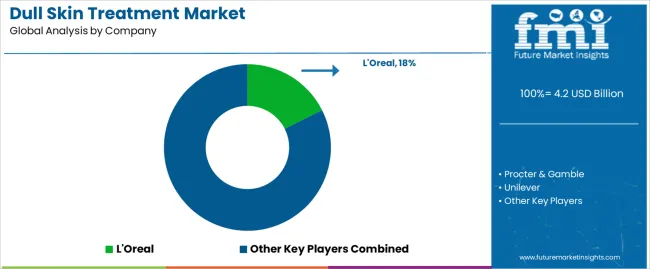Dull Skin Treatment Market Size and Share Forecast Outlook From 2025 to 2035
The dull skin treatment market is experiencing steady expansion driven by rising consumer awareness about skin health, growing demand for personalized skincare products, and advancements in dermatological formulations. Increasing influence of beauty and wellness trends, coupled with social media exposure, has intensified the adoption of specialized products targeting skin texture and luminosity improvement. The market is being shaped by innovation in active ingredients, incorporation of natural extracts, and technological advancements in formulation delivery systems.
Consumers are shifting toward multi-functional products offering hydration, brightening, and anti-aging benefits. The future outlook remains positive as manufacturers continue to invest in research and product diversification to cater to varied skin concerns and demographics.
Growth rationale is supported by increasing disposable income, expanding e-commerce distribution, and the proliferation of skincare clinics and dermatology centers These factors collectively contribute to the steady rise in demand for high-efficacy dull skin treatment solutions across global markets.

Quick Stats for Dull Skin Treatment Market
- Dull Skin Treatment Market Industry Value (2025): USD 4.2 billion
- Dull Skin Treatment Market Forecast Value (2035): USD 7.7 billion
- Dull Skin Treatment Market Forecast CAGR: 6.3%
- Leading Segment in Dull Skin Treatment Market in 2025: Serums And Ampoules (36.8%)
- Key Growth Region in Dull Skin Treatment Market: North America, Asia-Pacific, Europe
- Top Key Players in Dull Skin Treatment Market: L'Oreal, Procter & Gamble, Unilever, Estee Lauder, Shiseido, Johnson & Johnson, Beiersdorf AG, Avon Products, Inc., Revlon, Inc., Kao Corporation

| Metric |
Value |
| Dull Skin Treatment Market Estimated Value in (2025 E) |
USD 4.2 billion |
| Dull Skin Treatment Market Forecast Value in (2035 F) |
USD 7.7 billion |
| Forecast CAGR (2025 to 2035) |
6.3% |
Segmental Analysis
The market is segmented by Product Type, Skin Type, Consumer Orientation, Distribution Channel, and Mono Brand Store and region. By Product Type, the market is divided into Serums And Ampoules, Exfoliators And Cleansers, Moisturizers, Masks And Peels, and Others. In terms of Skin Type, the market is classified into Combination Skin, Dry Skin, Oily Skin, and Normal Skin. Based on Consumer Orientation, the market is segmented into Women, Men, and Unisex.
By Distribution Channel, the market is divided into Offline Stores, Modern Trade, Departmental Stores, Convenience Stores, and Specialty Stores. By Mono Brand Store, the market is segmented into Online Retailers, Other Sales Channel, Direct to Consumer, and Third-party to Consumer. Regionally, the market is classified into North America, Latin America, Western Europe, Eastern Europe, Balkan & Baltic Countries, Russia & Belarus, Central Asia, East Asia, South Asia & Pacific, and the Middle East & Africa.
Insights into the Product Type Segment

The serums and ampoules segment, accounting for 36.80% of the product type category, has emerged as the dominant segment due to its high concentration of active ingredients and fast-acting formulation properties. Demand growth has been supported by consumer preference for lightweight, easily absorbable products that deliver visible results in shorter durations.
Manufacturers are increasingly focusing on innovation in packaging, preservation, and ingredient stability to enhance product longevity and safety. The segment’s performance is further strengthened by widespread adoption through both professional dermatology clinics and direct-to-consumer channels.
Expanding product accessibility and increased awareness about preventive skincare routines have reinforced market leadership The segment is expected to sustain its share as continuous advancements in ingredient technology and consumer education drive higher engagement in daily skincare regimens.
Insights into the Skin Type Segment

The combination skin segment, holding 33.50% of the skin type category, has maintained its lead position owing to the diverse needs of this consumer group requiring balanced formulations. Product development has focused on creating adaptive solutions that address both oil control and hydration, ensuring overall skin harmony.
The segment’s growth is reinforced by its wide prevalence among consumers globally and the introduction of customized formulations suited for varying climatic conditions. Rising adoption of mild exfoliants, lightweight serums, and barrier-repair solutions has enhanced satisfaction rates and repeat purchases.
Brand strategies emphasizing dermatologically tested and non-comedogenic claims have further supported sustained market share As skincare personalization evolves, products designed for combination skin are expected to retain high market penetration and continued consumer loyalty.
Insights into the Consumer Orientation Segment

The women segment, representing 61.40% of the consumer orientation category, remains the primary revenue contributor due to heightened focus on skincare maintenance and aesthetic enhancement. Increased awareness through digital platforms, influencer marketing, and beauty education has significantly expanded engagement among female consumers.
Product innovation targeting age-related dullness, pollution-induced fatigue, and uneven tone has fueled higher adoption rates. The dominance of women in professional skincare services and retail purchases continues to drive consistent sales across both online and offline channels.
Premium product lines emphasizing natural ingredients, transparency, and clinical efficacy have strengthened brand positioning The segment is expected to maintain its leadership as women-centric marketing strategies, product diversification, and personalized skincare programs continue to align with evolving lifestyle and beauty trends globally.
Top Dynamics and Industry Trends Shaping the Dull Skin Treatment Market
- The significant increase in individuals adopting sedentary lifestyles is contributing to various health issues, notably dull skin. This shift in lifestyle is associated with a range of health concerns, and dull skin is among the notable effects.
- Reduced sunlight exposure from indoor lifestyles contributes to skin dullness. This has led to a heightened demand for skincare products that rejuvenate and brighten the skin.
- Rising concerns regarding environmental pollution, with harmful pollutants in the air causing skin damage and dullness, drive a growing demand for products that can help protect the skin from environmental damage and restore its natural glow.
- The aging population is a key driver of the dull skin treatment market, as skin undergoes changes with age. The market is witnessing a demand for anti-aging skincare products that brighten and rejuvenate.
Lucrative Opportunities Transforming the Dull Skin Treatment Market
- There is a growing trend toward natural skincare products, driving the growth of the organic dull skin treatment market as consumers prioritize chemical-free options with gentle, natural ingredients. Consequently, market players have the opportunity to develop multiple natural and organic skincare products specifically designed to address skin concerns.
- Rise of eCommerce has made it easier for consumers to access skincare products. Online sales of skincare products have been growing at a rapid pace, and businesses can leverage this trend to reach a wider consumer base. Developing a strong online presence and investing in digital marketing are expected to help businesses capture a larger share of the market.
- There is a growing interest in personalized skincare solutions. Consumers are looking for products tailored to their specific skin concerns and needs. Businesses can capitalize on this trend by offering personalized solutions that cater to individual skin types and concerns.
- Demand for innovative skincare solutions that offer quick and effective results is on the rise. Consumers are willing to pay a premium for products that deliver visible improvements in their skin health and appearance. Developing innovative products that offer quick and effective results can help businesses differentiate themselves in the market and drive growth.
Factors Restraining the Demand for Dull Skin Treatment Products
- There exists a demand for products that ensure both effectiveness and safety for consumers. With consumers growing more conscious of the potential risks tied to specific ingredients, brands are compelled to innovate and formulate products that are free from harmful chemicals and other toxins.
- Developing effective products requires careful research and development, as well as testing and monitoring to ensure that products meet the highest standards of safety and efficacy. This increases capital expenditure and may limit market expansion.
- There is a rising need to stay ahead of the latest trends and innovations. With new products and technologies constantly emerging, it becomes difficult for brands sometimes to stay up-to-date and maintain a competitive edge.
- The market shifts with consumer preferences. For instance, as interest grows in natural and organic products, brands must adjust their offerings accordingly. This necessitates a deep understanding of consumer preferences and investments in product development and marketing.
Dull Skin Treatment Industry Analysis by Top Investment Segments
In terms of Product Type, the Exfoliators Segment Leads the Market Growth
| Attributes |
Details |
| Product Type |
Exfoliators |
| Market Share in 2025 |
30.5% |
- Exfoliators are currently generating significant revenue in the dull skin treatment market due to their effectiveness in removing dead skin cells and revealing brighter, smoother skin.
- Consumers are increasingly seeking products that provide immediate results, and exfoliators fit the bill by offering instant gratification in the form of brighter, more radiant skin.
- Exfoliators are relatively easy to use and do not require a lot of time or effort, making them a convenient option for busy consumers.
- Increased consumer awareness about the importance of exfoliation in maintaining healthy skin is leading to growing demand for exfoliating products and an influx of new brands and products in the market
In terms of Distribution Channel, the Offline Store Segment is dominating the Market
| Attributes |
Details |
| Distribution Channel |
Offline Store |
| Market Share in 2025 |
57.5% |
- Customers, especially those experiencing skin problems such as dullness, blemishes, and uneven skin tone for the first time, prefer to purchase products from offline stores where they can receive guidance from sales associates.
- Offline stores are more prevalent in emerging markets where online shopping is less common. They have a greater presence and are more accessible to customers compared to online stores.
- In countries with large populations and a growing middle class, where individuals are willing to invest in skincare products, preference is given to purchasing from offline stores, regardless of whether discounts are offered.
- The skincare industry is heavily influenced by trends and fads. Offline stores are better equipped to keep up with these trends and stock the latest products. They also have the advantage of being able to quickly adapt to changing customer preferences and introduce new product lines.
Analysis of Top Countries Formulating, Certifying, Distributing, and Using Dull Skin Treatment Solutions
| Countries |
Forecasted CAGR from 2025 to 2035 |
| United States |
4.5% |
| United Kingdom |
8.0% |
| China |
9.4% |
| Japan |
10.8% |
| Australia |
7.2% |
Growing Aging Population in the United States Sparks Skin Treatments’ Demand

- The demand for dull skin treatment in the United States has been growing rapidly over the past several years due to the increasing awareness among consumers about the benefits of maintaining healthy skin.
- Consumers are now more conscious of their skin health than ever before, and they are willing to spend money on products and services that can help them achieve a healthy and radiant complexion.
- The growing aging population in the United States contributes to this trend. As people get older, their skin tends to become dull and lose its natural glow, leading to an increase in demand for anti-aging products and services that can help rejuvenate the skin and restore its youthful appearance.
- The United States has a highly developed healthcare industry, enabling the development of advanced skincare technologies and treatments. These advancements lead to numerous treatment options for consumers.
The United Kingdom’s Highly Competitive Skincare Landscape Positively Impacts the Market
- There is an increasing demand for medical and healthcare products in the United Kingdom, driven by consumers' desire to maintain a youthful and healthy appearance. With the rise of social media and celebrity culture, there is now more pressure than ever before to look good and maintain a flawless complexion.
- The United Kingdom boasts a highly competitive skincare market, which has spurred the development of innovative and effective skincare products and treatments. Consumers have access to a wide range of skincare products, including natural and organic options, as well as advanced treatments like chemical peels, dermabrasion, and laser therapy, among others.
China’s Access to a Wide Range of Skincare Options Fuels Market Growth
- Growing awareness about the harmful effects of pollution on the skin has also contributed to this trend. As air pollution levels continue to rise in many parts of the country, consumers are increasingly seeking products and services that can help protect their skin from pollution damage.
- Consumers in China have access to a wide range of skincare options, including traditional remedies, as well as advanced treatments like chemical peels, laser therapy, and microneedling.
Increasing Interest in Cosmetics in Japan Surges the Adoption of Skin Treatments

- There is an increasing interest in beauty and cosmetics among consumers. Consumers in this country are known for their high standards when it comes to beauty, and they are willing to invest in products and treatments that can help them achieve a flawless complexion.
- Japan’s skincare market is highly developed, leading to the development of advanced skincare technologies and treatments. Consumers here have access to a wide range of skincare products and treatments, including traditional Japanese remedies, as well as innovative treatments like facial massage and lymphatic drainage.
Growing Health Consciousness in Australia Sparks Demand for Skin Treatments
- Australia has a harsh climate in many parts of the country. With a hot and dry climate, Australia's weather can significantly impact skin health. This, in turn, has led to an increase in demand for products and treatments that can help protect the skin from sun damage and other environmental factors.
- Individuals in this country are highly health-conscious, leading to an increase in demand for skincare products and services that are natural, organic, and free from harmful chemicals. This trend has given rise to a growing market for natural and organic skincare products, which are seen as safer and more environmentally friendly than traditional skincare products.
Key Dull Skin Treatment Market Players and Concentration
The dull skin treatment market is highly fragmented, with numerous players vying for a share of the market. Key players are focusing on product innovation, strategic collaborations, mergers and acquisitions, and aggressive marketing to expand their market presence and gain a competitive edge. Additionally, companies are also concentrating on expanding their distribution channels to increase their market reach.
However, the market is facing intense competition from new entrants that offer innovative and affordable products. These new entrants leverage social media platforms to promote their products and gain market share.
Recent Development
- In 2025, Vaseline launched its latest range of skincare products that specifically target the needs of individuals with dull skin. This premium line has been designed with unique formulations that help rejuvenate and brighten dull skin, leaving it looking radiant and healthy. With this new range, Vaseline aims to help individuals with dull skin achieve a more vibrant and youthful complexion.
- In 2025, mCaffeine, a well-known skincare brand, expanded its product portfolio by launching a new 2-in-1 toner serum specifically designed to address the needs of individuals with dull skin. This innovative product combines the benefits of a toner and serum into a single formula, providing users with a comprehensive skincare solution that helps rejuvenate and brighten the skin.
Leading Suppliers of Dull Skin Treatment Products

- L'Oreal
- Procter & Gamble
- Unilever
- Estee Lauder
- Shiseido
- Johnson & Johnson
- Beiersdorf AG
- Avon Products, Inc.
- Revlon, Inc.
- Kao Corporation
Key Shifting Preferences Covered in Dull Skin Treatment Market Report
- Skin Pigmentation Treatment Market Report
- In-depth Dull Skin Treatment Analysis with Available Opportunities
- Skin Glow Enhancement Market Sales Assessment
- Detailed Skin Brightening Overview in Different Regions
- Skin Dullness Correction Treatment Pricing Outlook
Top Segments Studied in the Dull Skin Treatment Market Report
By Product Type:
- Exfoliators and Cleansers
- Serums and Ampoules
- Moisturizers
- Masks and Peels
- Others
By Skin Type:
- Dry Skin
- Oily Skin
- Normal Skin
- Combination Skin
By Consumer Orientation:
By Distribution Channel:
- Offline Stores
- Modern Trade
- Departmental Stores
- Convenience Stores
- Specialty Stores
By Mono Brand Store:
- Other Sales Channel
- Online Retailers
- Direct to Consumer
- Third-party to Consumer
By Region:
- North America
- Latin America
- East Asia
- South Asia
- Europe
- Oceania
- MEA
Frequently Asked Questions
How big is the dull skin treatment market in 2025?
The global dull skin treatment market is estimated to be valued at USD 4.2 billion in 2025.
What will be the size of dull skin treatment market in 2035?
The market size for the dull skin treatment market is projected to reach USD 7.7 billion by 2035.
How much will be the dull skin treatment market growth between 2025 and 2035?
The dull skin treatment market is expected to grow at a 6.3% CAGR between 2025 and 2035.
What are the key product types in the dull skin treatment market?
The key product types in dull skin treatment market are serums and ampoules, exfoliators and cleansers, moisturizers, masks and peels and others.
Which skin type segment to contribute significant share in the dull skin treatment market in 2025?
In terms of skin type, combination skin segment to command 33.5% share in the dull skin treatment market in 2025.














